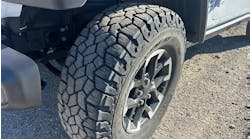In recent years, commercial truck tire manufacturers have begun embedding RFID (radio frequency identification) tags (microchips) into and onto their tires because of the benefits RFID technology can provide to both truck fleets and the tire manufacturers themselves.
RFID is the use of radio waves to read and capture information stored on a tag attached to an object, according to officials at Bar Code Graphics (www.barcode.graphics), a company that supplies automatic identification and data capture technology. A RFID system is made up of two parts: a tag or label – embedded with a transmitter and a receiver – and a reader.
The RFID component on the tag has two parts: a microchip that stores and processes information and an antenna to receive and transmit a signal, they explain. The tag contains the specific serial number for one specific object.
To read the information encoded on a tag, a two-way radio transmitter-receiver, called an interrogator or reader, emits a signal to the tag using an antenna. The tag responds with the information written in its memory bank. The interrogator will then transmit the read results to an RFID computer program.
PASSIVE AND ACTIVE
RFID tags are essentially microchips attached to an antenna that acts a transponder that always listen for a radio signal sent by transceivers or RFID readers, explains Peggy J. Fisher, president, TireStamp. For tires, passive RFID tags – which don’t require batteries – are used. This type of tag is powered by the radio signal that wakes it up and requests an answer.
When an RFID tag receives a certain radio query, it responds by transmitting back its unique ID code and any other information stored in it to the transceiver, she says. Since their transmission power is low, passive RFIDs are designed to actively communicate when they are within relatively close proximity of a passive RFID tag reader – between a few inches and a couple feet away.
TireStamp (www.tirestamp.com) is a leading developer of Tire Pressure Monitoring Systems (TPMS) and an asset intelligence company that provides expertise on tires and their effects on fleets’ operating costs, tire program management, asset management and other critical performance data to enable fleet users to reduce tire and fuel costs and improve productivity.
There are also active RFID tags. These have their own power source – typically a battery – and automatically transmit information to a reader at longer ranges than passive tags.
IT’S ABOUT TRACKING
“RFIDs provide a unique number, like a social security number, that identifies the tire and enables the tire manufacturer to track it through the manufacturing process, inventory and shipping to its final point of sale and end user,” TireStamp’s Fisher says. “Fleets can use RFIDs to track each tire’s history, which can be stored in the Cloud hosted by the tire manufacturer or in the fleet’s maintenance management software program.
“Retreaders can use RFIDs to track the tire from pickup at the fleet location through the retread process and delivery back to the fleet. The fleet’s or manufacturer’s software can contain the number of times the tire has been retreaded, repairs it has received, its pressure and temperature history, mileage, tread depths and cause of failure so that fleets are able to determine when a tire has reached the end of its lifespan and should be replaced.
“On a macro level,” continues Fisher, “fleets can analyze all the data in the database to determine the best tires and retreads to run in their operations, as well as make other informed decisions regarding the number of times to retread, age limits on retreading if any, detect problems with particular tires and if improvements in tire maintenance should be made.”
Michelin is using RFID technology to track performance of individual tires, efficiencies in supply chain and inventory so it can manage and predict tire life, says Maxine Osborne, director, Michelin Services Operations, Michelin Americas Truck Tires (www.michelintruck.com). Michelin (www.michelinman.com) designs, manufactures and sells tires for every type of vehicle, including airplanes, automobiles, bicycles, earthmovers, farm equipment, heavy duty trucks and motorcycles.
DATA COLLECTION
To manage its Fleet Solutions program, Michelin’s tire fleet leasing program, the company uses RFID patches on each tire position on a vehicle. The patches are applied to the sidewall of the tire. Additionally, QR (Quick Response) codes – device readable barcodes used to provide easy access to information – are applied to the vehicle.
Air pressure, tread depth and inspection data are collected by a handheld device and entered into the database against the RFID tag. An internal management system tracks the mileage and tire position data and allows the compilation of the information.
“Fleets have historically collected this information on paper, and the data was rarely utilized for efficiency gains and asset management due to the difficulty to organize and interpret it,” Osborne notes. “The Michelin system allows more accurate and effective collection and collation of the data and, with the thousands of tags deployed into the field, allows fleets to really utilize the information.
“The service program helps reduce risk, manage costs, save fuel, lower emissions and performance variables.”
Bridgestone has explored several technologies that allow for unique identification of a tire, says Jason Roanhouse, director of strategic business development, Bridgestone Commercial Group. “The benefits from these technologies center around the ability to assign data against the identifier – think of it like a social security number – for a tire that allows specific information to be collected on individual and groups of tires to provide valuable insights and improve decision making.”
Bridgestone Commercial Solutions, a business of Bridgestone Americas Tire Operations (www.bridgestoneamericas.com), provides tires and services for trucking, construction, mining, aggregates and industrial operations across the Americas. The division manufactures, markets and sells medium and heavy duty truck tires and off-road tires for the original equipment and replacement markets.
TRANSFER OF INFORMATION
Information from RFID tags can be transferred from a reader using Wi-Fi, cellular technology or a docking station, says Osborne of Michelin. Adds TireStamp’s Fisher: “There are readers on the market today that will read RFIDs, take tread depths and interrogate TPMS sensors to obtain tire pressures. The readers then send this information wirelessly to a PDA which then communicates this data to the fleet or a web portal.”
“The information in the tag does not change, but the operator can assign additional data against the RFID's identification number,” Bridgestone’s Roanhouse says. “This can be done at many points during the tire’s life, building a pretty rich history depending on the tire.”
The value of RFID is in the amount of information that can be assigned against the unique identifier located on the RFID tag, he points out. “The key question is how do we connect all of these data points in a database so maintenance systems can benefit from the aggregated data? Possible data collection points include manufacturing, retreading, repair, onsite service and emergency service.
“This is a lot of possible touch points and something the industry will need to address.”
The benefits of RFID for tires “are mainly associated with tracking at this point, but they may become part of a national recall identification system that will enable technicians to scan the tire to check for a recall,” says Kevin Rohlwing, senior vice president of training, Tire Industry Association (www.tireindustry.org), an association representing all segments of the tire industry. “In the event of a national recall on truck tires, RFID tags could be incredibly valuable in finding those recalled tires and removing them from service.”
TAG PLACEMENT
There are a number of ways to place an RFID tag in a tire during its manufacture, and many are proprietary in the new tire process, say Michelin’s Osborne. Bridgestone’s Roanhouse points out that “millions of miles of testing have been done to insure the proper location.”
The RFID tags that are “placed” into tires are tiny, about the size of a grain of rice, and weigh only a couple of grams, Fisher of TireStamp says. They are designed to be embedded in the sidewall of a tire. Special packaging is used to resist heat, cold and harsh chemicals.
Post manufacture is typically through chemically or heat/pressure cured patch type tags, says Roanhouse.
Osborne points out that RFID tags have been engineered to withstand the retread process. Roanhouse adds that RFID tags have proved reliable enough to retread numerous times.
TAG READERS
Can any RFID tag reader “read” any tire brand RFID tag or is a reader “associated/paired” with a particular tire brand?
“Essentially, any standard RFID reader can read the identification number from a tag,” says Osborne of Michelin. “Encrypted information requires a decode key to unlock the information.”
“The reader/RFID technology is not unique,’” adds Bridgestone’s Roanhouse. “But how the data is arranged on the tag and how the reader interprets the data is important to reading the tag.”
TireStamp’s Fisher says the industry has been working for years on ensuring that all tire manufacturers’ RFID tags can be read by one reader, and observes that Technology & Maintenance Council (TMC) has promoted this in its RPs dating back to the 1990s.
“In 2013, Michelin offered to license, free of charge, its RFID technology in order to adopt a global, industry standard which would accelerate the deployment of this technology by all tire manufacturers, drive RFID volumes up and RFID costs down,” she says. “Since then, many tire makers have announced their use or intentions to use RFIDs.”
Michelin began to offer the RFID technology in 2013.
Fisher says there are standards for RFID tags established by organizations such as the AIAG (Automotive Industry Action Group), AIM (Association for Automatic Identification and Mobility) Global and TMC that exist to ensure RFID readers can read tags, regardless of tire manufacturer or RFID supplier.
AIAG (www.aiag.org) is an association that works to streamline industry processes via global standards development and harmonized business practices. AIM Global (www.aimglobal.org) is an association that helps its members grow their businesses by fostering the effective use of automatic identification and data capture solutions. TMC (www.trucking.org/Technology_Council.aspx) is an organization that works to improve transport equipment, its maintenance and maintenance management.
Bridgestone has implemented RFID in specific products and demonstrated that the technology is viable, says the company’s Roanhouse. Evaluation and implementation has taken place over the past several years.
Bridgestone is looking at several asset tracking technologies, including RFID, he adds. “Our primary objective is to provide our fleet customers with the best overall strategic value in asset tracking. The value is in better decision making through insights. These insights are generated through data collection and tire identification.”




